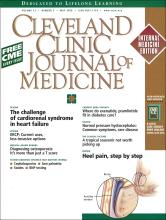ABSTRACT
Although densitometry has contributed immensely to detecting primary osteoporosis, it is only a tool that generates some useful numbers to guide diagnosis. The T score, a leading diagnostic marker for primary osteoporosis, must be put in its proper context. It is but one measurement that is quite useful in one cohort of patients, namely, postmenopausal women older than 60, but it can be misleading in others. The z score is a more descriptive measurement of bone loss in younger patients. However, both the T score and z score are limited in their diagnostic potential and must be incorporated with other diagnostic aspects, such as family history, laboratory results, and genetic influences. In the end, physicians diagnose osteoporosis, not densitometry.
- © 2006 The Cleveland Clinic Foundation. All Rights Reserved.






